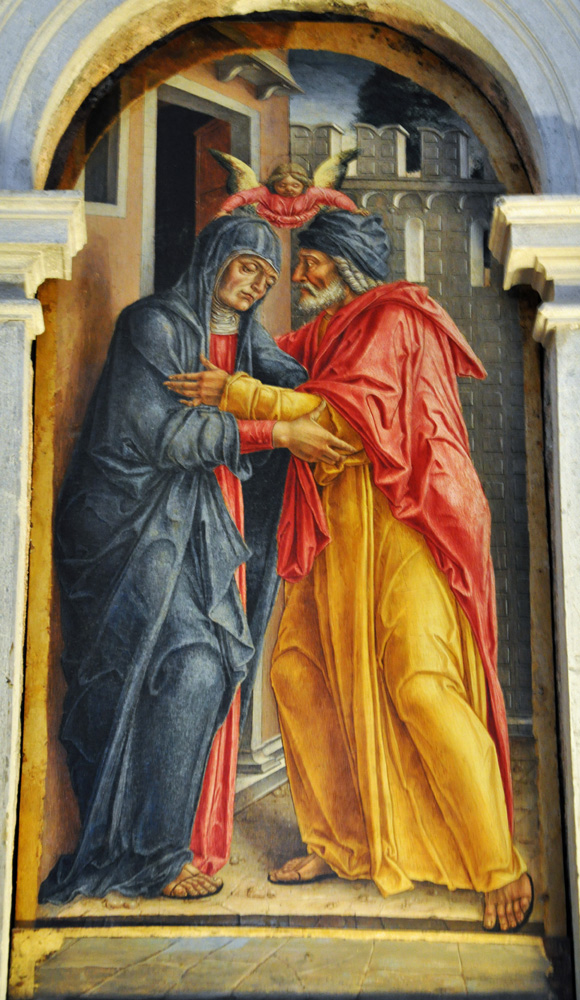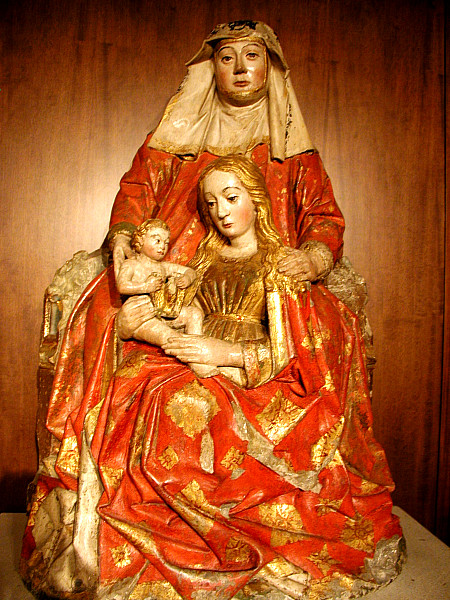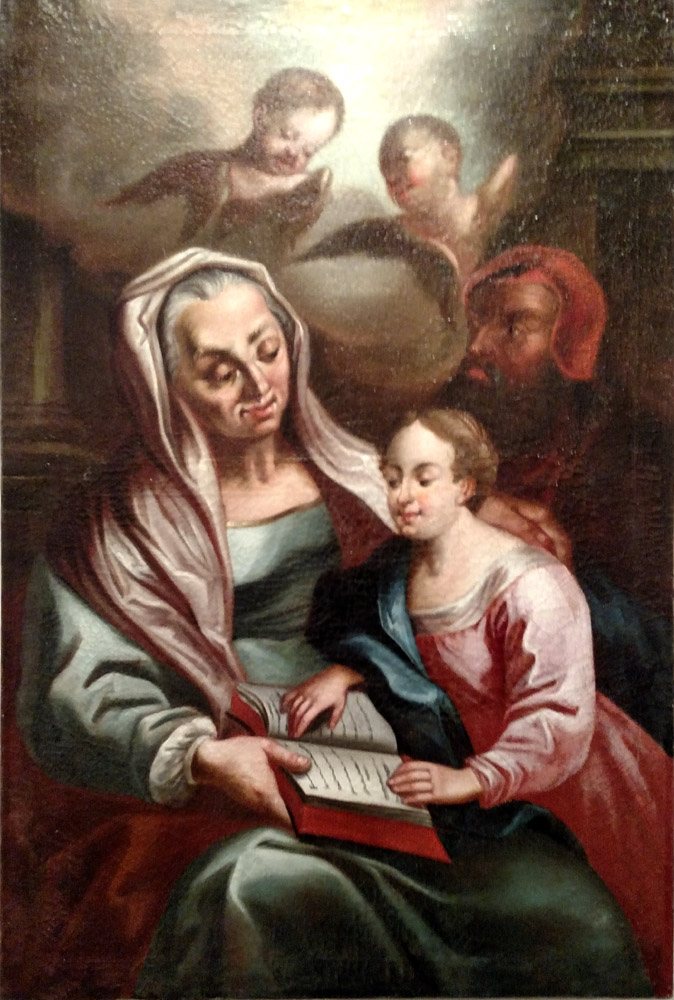NARRATIVE IMAGES
The Meeting at the Golden Gate
As the story goes, Anne and Joachim went 20 years without having children. Consequently Joachim was refused entrance to the Temple and took his sheep into the hills with a heavy heart. But then an angel announced to the two that their prayers for a child were answered and they should meet at the Golden Gate of the Temple. Mary was born nine months later.Until the late medieval period, St. Anne is seen mostly in narrative images based on this story. The two episodes most commonly painted are the Golden Gate and the Birth of Mary. The latter is treated at this page on the web site. The typical Golden Gate image shows Anne and Joachim embracing (example), sometimes with the encouragement of an angel who places his hands on their heads (as at right). In the 14th century England saw an effusion of images in which Anne teaches her daughter to read (example). This image type soon became popular in northern Europe, and it continued to be a favorite into modern times (example). Unlike other popular forms, it did not arise from any scriptural or apocryphal narrative. Miles (635) has suggested that it was a "back-formation" first introduced to show how Mary came to be literate and thus could have been studying the scriptures when the angel arrived at the Annunciation, as many images pictured that scene (example). Sheingorn relates its development to the increasing emphasis on women's literacy in the late Middle Ages, when women in the upper classes came to be expected to be able to read and to teach reading to their daughters.
In many examples of this image type, Anne points to a specific passage in the text that Mary is reading (example), suggesting that she was not simply teaching Mary her ABCs but was helping her learn to interpret scripture. This is especially the case in this statue group, where Anne counts on her fingers, a conventional way of picturing the act of teaching doctrine. Medieval commentators saw in the young Mary a model student of the Bible and its prophecies. The influential Gospel of pseudo-Matthew called her "learned in the law of God," and Bede suggested that her question to the angel, "How shall this be done, because I know not man?" (Luke 1:34) arose specifically from her understanding of Isaiah 7:14 (Miles, 641). This erudition and its source in Anne appears to be the point of this painting, which pictures Mary after she has been affianced to Joseph but before the Annunciation, literally enlightened while she points to a line in the book that Anne holds on her lap. A similar painting in Rome makes the same point. St. Anne is portrayed alone in this Orthodox mosaic in Palermo, but in the West she is almost always portrayed with others of her kindred.
Anna Selbdritt
Popular devotion to St. Anne gave rise to a new iconographic type known as Anna Selbdritt (literally, "Anne herself the third"), as in the second picture at right. Typically Anne is shown as a mature adult posed with the Christ Child and a Mary who is usually quite young. Images of this type were especially common between about 1480 and 1520 in northern Europe.The type may have evolved from Birth of Mary images such as this one from the 14th century, where the small figure of Mary on Anne's lap holds on her own lap a smaller image of the Christ Child. Another clear influence is the Madonna and Child type, with Anne replacing Mary as the primary figure. Indeed, in this sculpture Mary becomes a diminutive figure at her mother's knee while Anne stands with the Christ Child in her arm. In a few cases I have encountered, the child holds an orb, a detail borrowed from Madonna and Child images (example).
In the late 15th and early 16th centuries several ways of arranging the figures developed. Sometimes they are disposed vertically, as we see in the second picture at right, in a pattern resembling that of the Throne of Wisdom. A statue from Belgium seems influenced by the Throne of Wisdom type in having the child on Mary's lap holding a book, though both Jesus and Mary perch sideways on St. Anne's right arm. Other images have Anne holding her daughter and grandson in each of her two arms, as in this stained glass in Munich.
A third pattern seats St. Anne and Mary side-by-side with Jesus between them or on a lap. This allows for the addition of secondary figures behind the two women. For example, the Anna Selbdritt sculpture in the Metropolitan Museum places St. Anne's mother St. Emerentia behind the seated women.
The Holy Kinship
In the Golden Legend Anne has three husbands, three daughters (all named Mary), three sons-in-law, niece Elizabeth, grandnephew John the Baptist, and seven grandchildren, including five apostles and Jesus himself. Images of this "Holy Kinship" were popular in northern Europe in the late Middle Ages (example).ANNE'S AGE
In these images Anne's apparent age varies. Usually she appears to be a vigorous adult just a few years into middle age, as in the first two images at right. But as early as 1490 Lorenzo d'Alessandro's painting ages her and moves her into a dark background. After 1520, many northern examples follow this practice (Nixon, 121-31). In the third picture at right, a German painting from the 18th century, she is in the foreground but quite elderly.
Prepared in 2014 by Richard Stracke, Emeritus Professor of English, Augusta University. Revised 2015-07-29, 2016-09-02, 2017-12-03.
HOME PAGE

Anne at the Golden Gate with St. Joachim (Bartolomeo Vivarini, 1484: See the description page)

An Anna Selbdritt (Spain, 17th-century: See the description page)

Anne teaching Mary to read (German, 18th century: See the description page)
MORE IMAGES
- 1350-55: Nardo di Cione's fresco of SS. Anne and Joachim at the Golden Gate.
- Circa 1480-1524: Anne seems hardly older than her daughter in this painting from the workshop of Leonardo da Vinci.
- Circa 1490: Anne holds Mary and the Christ Child in her two arms in this small private "altarpiece" from Swabia.
- Circa 1500: A tapestry pictures the Holy Family with St. Anne offering a rose to the Christ Child.
- Early 16th century: A statue in Brabant adapts the iconography of Anne teaching Mary to an Anna Selbdritt.
- 16th century: Anna Selbdritt in high relief.
- 1540: Anne engages in a vigorous conversation with her son-in-law Joseph in Tintoretto's Madonna and Child with Saints.
- 1547-51: Altarpiece panel of the meeting at the Golden Gate.
- 1690: An Anna Selbdritt with the Trinity and Saints Joseph and Joachim.
- 17th century: Sculpture group: Anne teaches Mary to read.
- 17th/18th century: Litterini's St. Anne with St. Joseph and St. Anthony of Padua
- 18th century: A portrait in silver of Anne and Mary with no child or book.
- 1817: In a mosaic in Palermo's Palatine Chapel Mary has the circlet of stars associated with the Immaculate Conception and Anne refers the viewer's gaze upward from the girl to Heaven.
DATES
- Feast day: July 26
BIOGRAPHY
- Golden Legend #131: html or pdf
- Protevangelium of James
- The Gospel of Pseudo-Matthew
- Bokenham, A Legend of Holy Women, 29-42
- Acta Sanctorum, July vol. 6, 233-297
ALSO SEE
- St. Joachim
- The Birth of Mary
- The Throne of Wisdom
- The Holy Kinship (Anne and Mary's extended family)